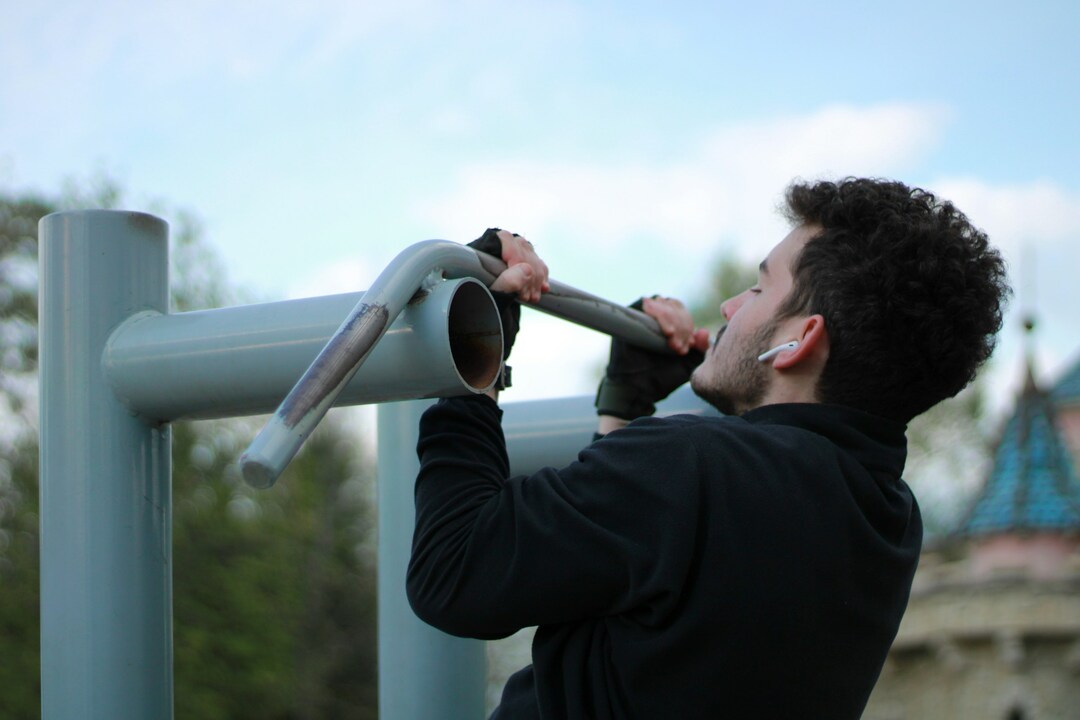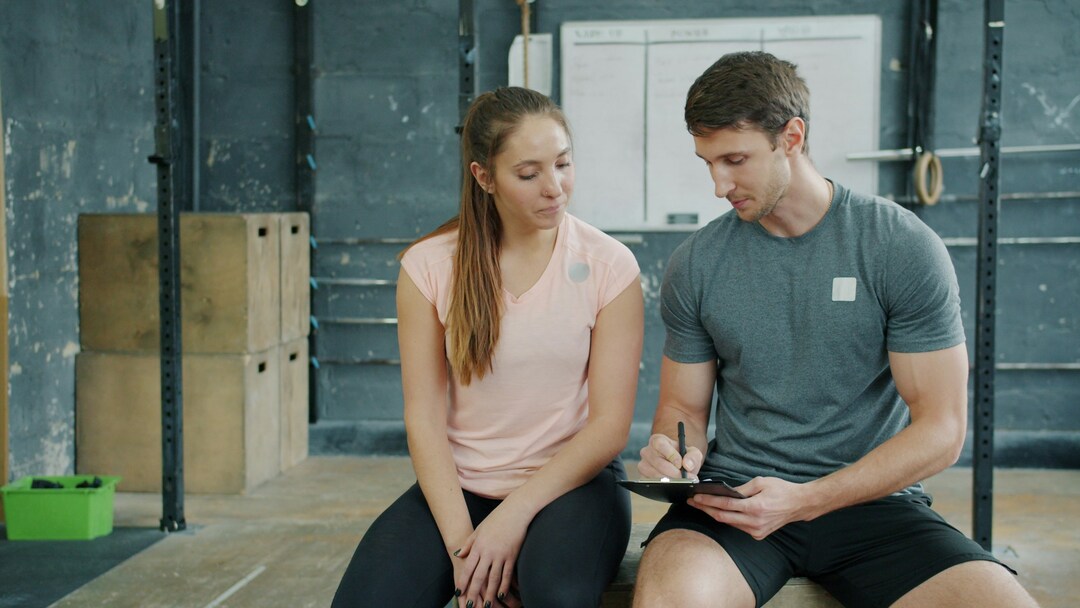How Many Pull-Ups Should I Be Able To Do?

Wondering how many pull ups should I be able to do? Discover what’s considered average, good, or elite for your fitness level in this quick
Pull-ups are a clear test of upper-body strength, and they show up across Best Fitness Apps as a key performance metric. How many pull-ups should you be able to do for your age, body weight, and training level?
This article lays out realistic benchmarks for beginners through advanced athletes, shows how to test strict reps and form, and explains practical progressions like assisted pull-ups and negatives to help you track gains. Ready to measure your current max and plan the next steps?
GetFit AI, an AI fitness app, gives simple strength assessments and tailored pull-up benchmarks, then delivers guided workouts and form tips to help you assess performance, build strict reps, and safely increase your max.
Summary
.jpg)
- Pull-up ability depends on context not a single target, with Everyday Health benchmarks showing average men do 6 to 12 pull-ups and average women do 1 to 5, which highlights that population norms are checkpoints rather than prescriptions, and programming should match sport and bodyweight; This is where GetFit AI fits in, offering tailored pull-up benchmarks based on your age, bodyweight, and training history.
- Neural readiness and planned progressions matter as much as raw strength, so the article recommends predictable increases in load or reps every 7 to 21 days to drive adaptation rather than random jumps; GetFit AI addresses this by mapping micro goals and 7 to 21-day progression windows into adaptive schedules.
- Micro technique and small mobility habits produce significant changes, for example, five minutes of banded wall slides and checking that the descent does not collapse faster than three seconds can reveal immediate gains in clean reps. This is where GetFit AI fits in, by providing form tracking and metrics like wrist angle and time-under-tension to make those micro adjustments measurable.
- Programming frequency and periodization drive repeatable improvements, with a recommended 3 to 4 short, focused sessions per week and block structures such as 4 to 6 week strength phases followed by 3 to 4 week density phases within a 4 to 12 week training block; GetFit AI addresses this by scheduling 3 to 4 focused sessions and periodized 4 to 12 week blocks aligned to your goals.
- Nutrition and connective tissue strategies support consistent loading, for example maintaining protein around 1.6 to 2.2 grams per kilogram and using collagen or gelatin with vitamin C about one hour before loading can aid tendon adaptation, while isometric holds have been shown (Rio et al., 2015) to provide short-term analgesia for tendinopathy; This is where GetFit AI fits in, by integrating evidence-based nutrition targets and tendon-friendly loading recommendations into session timing.
- Small, measurable feedback beats guesswork, so test an on-rep-max every 3 to 4 weeks, use clusters like four sets of three with 15 to 20 seconds rest for a 12-rep target, and track metrics over time, and note that real-user data shows 80% of GetFit AI users reported improved fitness within 3 months and a 90% customer satisfaction rate; GetFit AI addresses this by converting athlete-inspired templates into personalized, autoregulated training and progress tracking.
How Many Pull-Ups Should the Average Person Be Able To Do?

A reasonable way to think about how many pull-ups you should be able to do is this: aim first for a single strict rep done with perfect form, then build toward multiple clean reps that match your sport, bodyweight, and training history. The raw number matters less than consistent improvement, control at the top and bottom, and how those reps translate into performance for what you actually do outside the gym.
You will see broad averages, but those figures flatten significant differences in bodyweight, grip length, and training background. According to Everyday Health 2025, the average man can do 6 to 12 pull-ups, reflecting population averages among adult men and helping set a reference point, not a prescription. Use that as a checkpoint, not a ceiling.
How should you set realistic short-term targets?
Start with outcomes you can measure each week, such as a strict dead-hang hold, five assisted reps with perfect form, or a weighted scapular pull-up progression. For women, consider population norms as a useful benchmark, since Everyday Health (2025) reports that the average woman can do 1 to 5 pull-ups, which provides context for programming and recovery expectations—then scale volume, frequency, and assistance. Hence, each session leaves you stronger without breaking technique.
What training details actually move the needle?
Focus on three things: the optimal mix of volume and intensity, accessory work for the posterior chain and scapular control, and a predictable progression that increases load or reps every 7 to 21 days. Think in terms of micro goals, not heroic single sessions, and track small wins like adding two reps across sets, faster concentric speed, or cleaner lockouts. Those are the changes that compound into reliable double-digit gains when they matter.
How will you tell if your goal fits your sport or body?
Compare pull-up reps to functional demands. If you are a climber or wrestler, strength-to-weight ratio matters more than raw reps; if you row or throw, tempo and endurance under tension may be the better metric. Use field-relevant checkpoints to guide whether you push for more reps, add weight, or tighten form.
Average Pull Ups by Age and Experience Chart
Pull-up abilities can be classified into experience levels (novice, intermediate, advanced, and elite), with corresponding expected reps varying by age and sex. Strict pull-ups from a dead hang (no kipping) are generally used to measure these standards.
Males
Novice
Under 18
0-1
18-39
0-2
Over 40
0-1
Intermediate
Under 18
1-4
18-39
6-8+
Over 40
4+
Advanced
Under 18
4-8+
18-39
10-12+
Over 40
8+
Elite
Under 18
10+
18-39
15+
Over 40
12+
Females
Novice
Under 18
0
18-39
0-1
Over 40
0-1
Intermediate
Under 18
2-3
18-39
2-6
Over 40
1-2+
Advanced
Under 18
4+
18-39
8+
Over 40
4+
These values reflect general fitness expectations rather than strict requirements and emphasize strict form over kipping or other assisted variations.
Many people find that solutions such as GetFit AI, which convert athlete-inspired progressions into individualized plans and provide real-time feedback, make the small, measurable steps feel less like guesswork and more like momentum for consistent gains.
That sounds like a tidy framework, but the real tension comes from what actually determines your ability to climb from one rep to many.
Factors That Determine How Many Pull-Ups You Can Do
.jpg)
Pull-up performance comes down to more than raw strength; technique choices, nervous system readiness, recovery, equipment, and tissue health each shape what your body can actually do on the bar. If you treat pull-ups like a single muscle test, you miss the mechanical and neural levers that either limit or multiply your results.
What does your nervous system control that strength tests do not?
Your brain and spinal cord decide how and when muscles fire. Fast, coordinated recruitment matters for clean reps, especially when fatigue sets in. Think of the nervous system as the ignition system of a car, not the engine; with a weak spark, even a big engine underperforms. Training that targets rate of force development, explosive concentric pulls, and controlled eccentrics teaches the nervous system to organize muscles more efficiently, which raises rep capacity without always adding muscle mass.
How do tempo and set structure change the work each rep does?
Two identical rep counts can feel completely different depending on tempo and rest. Slower eccentrics increase time under tension and stimulate tendon adaptation, while short, sharp concentric efforts train speed and recruitment. Cluster sets, submaximal multiple sets, or brief isometric holds at the top each bias different adaptations, so your program design should match the adaptations you want: one-rep max strength, repetition endurance, or explosive power.
How much do recovery and daily physiology influence a single session?
Your last 48 hours matter. Low-grade inflammation, poor sleep, or being in a calorie deficit will blunt neural drive and slow force production, even if your muscles are intact. Tendons and connective tissue respond slowly to loading, so inconsistent recovery leads to short-term plateaus that appear to be stagnation but are actually missed repair windows. Strategic nutrition and prioritized sleep let training sessions translate into gains instead of fatigue accumulation.
What role do equipment and small mechanical changes play?
A thick bar or rotating rings shifts demand from pure pulling to grip endurance and forearm stabilization, changing which reps feel possible. Neutral, supinated, and pronated grips each move the leverage and recruit the arm and back muscles differently, so a slight change in hand placement can instantly add or take reps. Environment matters too; a wobbly bar requires motor control that steals effort from vertical pulling.
How do joint health and tissue properties limit progress?
Tendon stiffness, previous rotator cuff irritation, or shoulder capsule tightness can force you into protective movement patterns that waste energy. Those protective adjustments often subtly reduce the range of motion, increasing perceived difficulty without lowering body weight or strength. Paying attention to tendon loading progression and addressing niggles early prevents chronic limitations that masquerade as weak pulling power.
Do left-right imbalances or coordination gaps hide actual capacity?
Often one arm or one side of the back produces more force, and the brain compensates with awkward torso shifts. That asymmetry makes repeated clean reps harder because the pattern breaks down under fatigue. Single-arm diagnostics and targeted unilateral work expose and fix those gaps faster than piling on more bilateral volume.
Many athletes find that tracking tempo, bar type, and left-right force trends with an intelligent app removes the guesswork, making minor adjustments measurable and meaningful in daily training.
That detail you think is minor now will surprise you when perfect form becomes the only thing standing between you and double-digit reps.
Related Reading
- Average Bench Press By Age
- Average Grip Strength Male
- Average Male Bench Press
- Grip Strength Chart
- How Much Can The Average Man Bench Press
- How Much Does A Bench Press Bar Weigh
- Average Bench Press
How to Do a Perfect Pull-Up
.jpg)
A perfect pull-up comes down to a few high-gain details you can control every rep: breath and intra-abdominal pressure, precise wrist and head alignment, and small mobility habits that let your shoulders track cleanly. Nail those, and the technique becomes repeatable, not just impressive.
How should you breathe and brace during a rep?
Breathe with intent. Take a full diaphragmatic inhale and settle the ribcage before you pull to create a stable core. For heavy, low-rep work, use a short, braced breath at the start to lock the torso, then exhale once you reach the top; for higher-rep sets, use a steady inhale on the descent and a short exhale during the concentric. This simple change preserves spinal stiffness without turning every rep into a gasp.
What are the micro technical cues that change a rep’s quality?
Watch two small things: wrist-to-forearm alignment and head position. Keep the wrists neutral—not cocked back—so the force travels straight through the elbow and into the lats. Tuck the chin just enough so the chest, not the forehead, rises above the bar; that subtle ribcage tilt shifts the pull's direction toward back engagement rather than neck strain. Also, learn the difference between a chin-up and a chest-to-bar pull, and choose the variant that aligns with your goal for strength or sport transfer.
Which mobility and prep habits yield the most significant dividends?
Prioritize thoracic extension and scapular upward rotation, not just shoulder stretches. Five minutes of banded wall slides, 30 seconds of soft-tissue work along the posterior shoulder and lat, then three scapular depressions before your first set will often reveal immediate cleaner paths on the bar. Think of it like freeing a hinge, so the shoulder can rotate where it needs to instead of borrowing motion from the neck or lower back.
How do you find the small, hidden leaks that steal reps?
Use video feedback from the side and the front, and check three markers: is one shoulder consistently higher, does the torso lead forward before the arms, and does the descent speed spike? Film at playback speed and at half speed to see timing errors you cannot feel. If the top position lasts less than a beat or the descent collapses faster than three seconds, you are leaving strength on the table.
Why do coaching cues sometimes fail you, even when they seem correct?
Because coaching often gets noisy, with unrelated fixes thrown into a single session. I’ve seen athletes overwhelmed by contradictory tips that blur what actually needs correcting. Strip cues to one measurable change per set, track it, and move on; that discipline beats endless tinkering.
Many athletes find that tools that translate elite routines into stepwise drills and track small metrics, such as wrist angle and time under tension, make those micro-adjustments easy to measure and repeatable in daily training.
That technique sounds finished, but the frustrating truth is that the next barrier is rarely about strength alone, and it will force you to rethink how you practice.
Related Reading
- Do Pull Ups Work the Chest
- Symmetric Strength
- Average Male Deadlift
- Average Deadlift Weight
- Grip Strength Norms
- Good Bench Press Weight
- 1 Rep Max Chart
- Weightlifting Standards
- Bench Press Standards
How to Increase My Pull-Up Reps

You increase pull-up reps by changing how you distribute effort across the week, tightening the small non-pull-up habits that sap reps, and using simple, measurable tweaks to push past plateaus. Do that consistently, and rep gains stop being flaky and start feeling inevitable.
How often should you hit the bar each week?
Treat pull-ups like a motor skill more than a one-off max test. Schedule 3 to 4 short, focused sessions instead of one long grind. Make each session have a clear intent, for example: one heavy day to overload with added weight, one speed or quality day for fast concentric work and strict technique under low fatigue, and one high-volume day using assistance or banded sets to build total reps. That distribution trains both the strength and the “repeatability” of the movement without piling on recovery debt.
What small things outside workouts steal your reps?
Grip fatigue, poor core tension during daily chores, and even how you sleep matter. Add targeted, low-cost fixes: two short towel hangs or farmer carries after work twice a week, a 60-second core brace drill before your pull-up sets, and a nightly mobility habit that opens thoracic extension. These actions do not look dramatic, but they raise the ceiling on how many clean reps you can string together by preserving energy for the actual pull.
Should you change your bodyweight to get more reps?
Yes, but plan it like a surgical adjustment, not a crash diet. Aim for slow, sustainable fat loss while keeping protein high and resistance training consistent so you preserve muscle. A practical rule, supported by sports nutrition guidance, is to maintain protein around 1.6 to 2.2 grams per kilogram of bodyweight and target modest weekly deficits, which keeps pulling strength while lowering the mass your lats must move.
How do you break a plateau without guessing?
Measure, then adjust. Use a one-rep-max test every three to four weeks, track reps at a fixed bodyweight and grip, and log session RPE or reps-in-reserve. If your best set stalls for two tests, change only one variable—for example, move from straight sets to short clusters or add 3-5% to weighted reps. That single-variable change tells you whether the limit was volume, force production, or recovery, instead of leaving you stuck in trial-and-error.
Which training tools offer the greatest return on time?
Clusters, short rest pauses, and grip-specific conditioning amplify usable work without lengthening sessions. For instance, split a 12-rep target into four clusters of three with 15 to 20 seconds rest, or use a 5-second hang between reps to improve tendon tolerance. Pairing a short grip challenge, like 30 seconds on a thick bar, before your main sets makes later pulls feel more secure and often yields an extra rep or two in testing.
How do mental habits turn into physical reps?
Routines matter. Begin your session with the exact warm-up, one consistent cue for the first pull, and a short micro-goal like “three solid reps this set.” Those small rituals lower the cognitive friction that turns a training day into an excuse. I’ve heard athletes describe the relief of turning intention into routine, how that first reliable rep quiets doubt and primes the rest of the set.
Many athletes find that platforms like GetFit AI make this process easier by converting athlete-inspired templates into personalized, autoregulated schedules and by tracking the small metrics that reveal real progress. That kind of feedback turns subjective guessing into clear next steps.
Think of improving pull-ups like tuning a chainsaw: sharpen one tooth at a time, check alignment, and only then swing harder.
But the surprising barrier you will run into next is not strength or technique; it is the way you choose to practice.
Tips for Getting Better at Pull-Ups
.jpg)
Start with a plan that moves beyond single sessions: pick 4 to 12-week blocks with a clear objective, then measure one repeatable test in each block so progress is trackable and not just anecdotal.
How do you periodize pull-up work across months?
Treat pull-up training like a skill that alternates focus. Run a concentrated-strength block for 4 to 6 weeks, then follow with a 3 to 4-week density or endurance block, and finish with a short power or speed block before a planned deload. Use a single, repeatable test per block—for example, a strict bodyweight max at a set grip and time of day—so your improvements are real and comparable. Think of the plan like tuning a camera lens: each block sharpens one setting, then you recheck focus with the same target shot.
Can brief heavy holds or specific warm-ups change how many reps you get that day?
Yes. Short, near-maximal isometric holds at the top of the pull-up, performed 2 to 3 minutes before a max-effort set, can transiently improve motor unit recruitment and give you cleaner, harder pulls for one or two sets. Use two to four holds, each for five to eight seconds, with full recovery between them, then rest for 60 to 120 seconds before attempting your test set. Reserve this for sessions where you want a high-quality max —not every workout —because it taxes the nervous system.
What nutrition and supplementation tactics support tendon and repeated-strength gains?
Simple steps matter most. Creatine supplementation has strong evidence for increasing short-term strength and repeated-effort performance, as summarized in the International Society of Sports Nutrition position stand (2017). For connective tissue, some clinical research indicates that taking a collagen or gelatin supplement with vitamin C about an hour before loading can increase markers of collagen synthesis in the short term, which helps tendons adapt to increased demand. These are small, low-risk interventions that help you sustain higher training loads over the course of weeks.
How should you handle tendon pain without derailing weeks of work?
Use isometric loading as a management tool, not a cure. Research led by Rio and colleagues in 2015 showed that targeted isometric contractions can provide immediate analgesia for tendinopathy, allowing athletes to perform meaningful loading with less pain. Apply short isometric holds at tolerable intensity before a session, then follow with graded, progressively heavier eccentric and concentric work across days and weeks. If pain persists or changes quality, escalate to a clinician rather than grinding through discomfort.
How do you make practice translate to sport or test-day performance?
Build specificity at the end of your block. If you need high-rep endurance for your sport, finish the block with longer, continuous sets and shorter rest periods. If you need single-effort strength, finish with low-rep heavy pulls and 2 to 4-minute rests. Record one consistent performance metric each time so you can see whether the block improved the thing that actually matters, not just arbitrary rep counts.
Many athletes find that an app like GetFit AI’s AI fitness trainer turns these concepts into personalized blocks and real-time adjustments, so the right mix of isometrics, load, and timing shows up when it actually fits your schedule and recovery.
That progress will feel satisfying until you realize the next barrier isn’t your body, it’s how closely your training mimics the person you want to be.
Related Reading
- Best Calisthenics Workout App
- Best Workout Tracker App
- Average Deadlift Weight For Male
- Best Workout Apps
- Average Bench Press By Age 16
- Best Hiit Workout App
- Best Gym Workout App
- Average Bench Press Kg By Age
- Best Free Workout Apps
- Average Deadlift Weight Kg
Make Your Favorite Athlete Your Fitness Trainer | Try GetFit AI's AI Trainer App for Free Today 💪
If you want pull-up targets rooted in what actually moves the needle for your body and sport, try GetFit AI’s AI fitness trainer app so you can follow athlete-inspired progressions without the guesswork. I recommend it because real users saw results. According to the GetFit AI User Survey, 80% of users reported improved fitness levels within 3 months, and satisfaction is intense, per GetFit AI customer feedback, which points to steady, measurable progress rather than vague promises.




.png)











